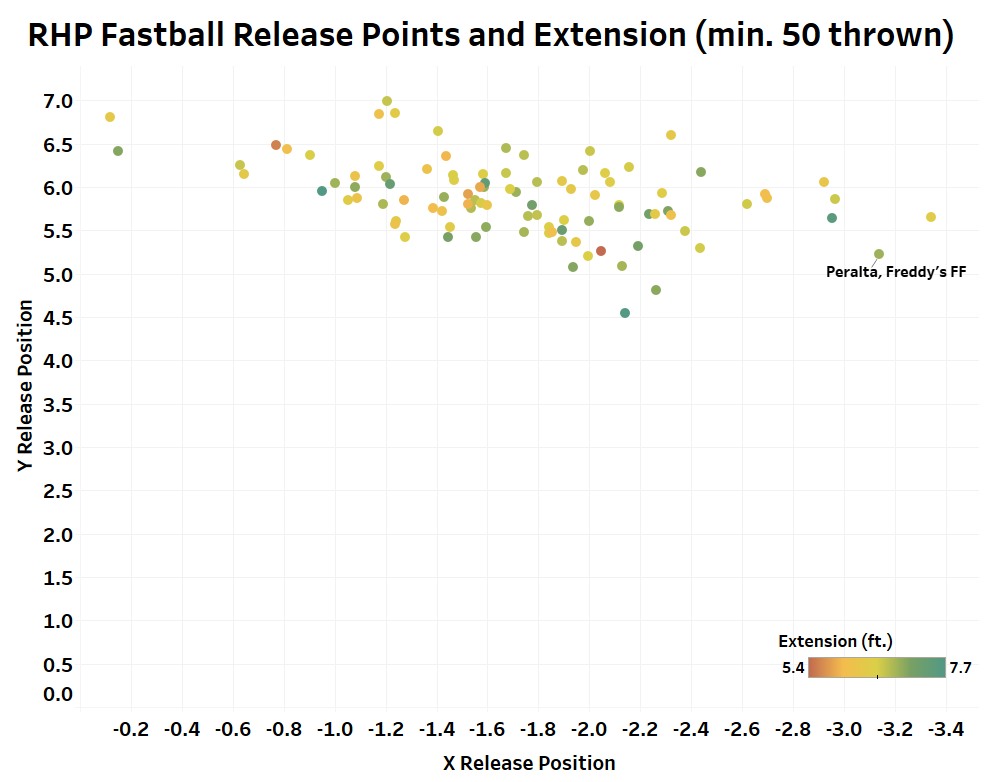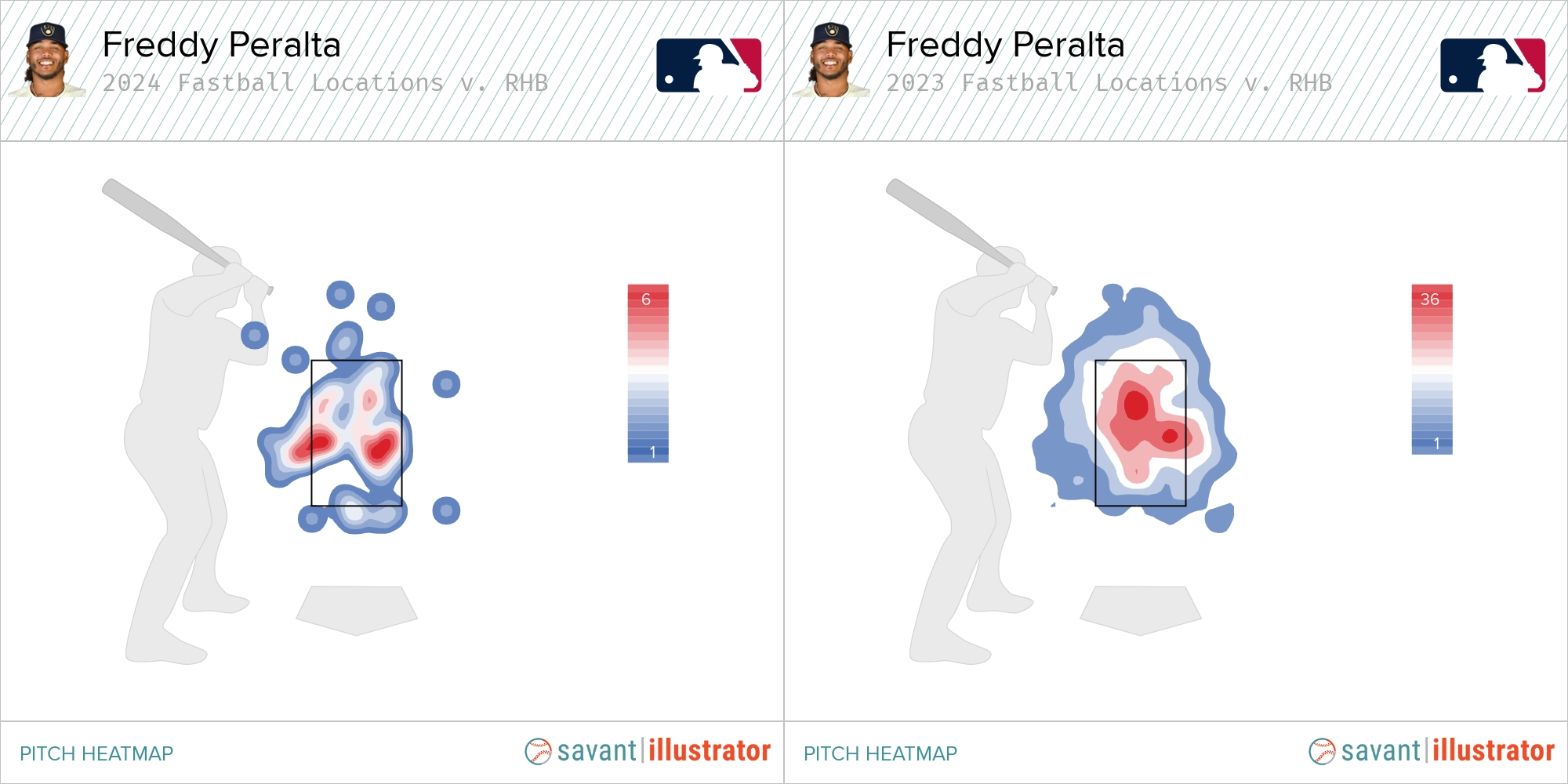It wasn’t long ago that Freddy Peralta’s nickname at Pitcher List was Professor Chaos.
He’s always had a filthy arsenal, but Peralta seldom knew where any pitch was going early in his career. From a “likely reliever” without a defined role to the third in Milwaukee’s three-headed monster rotation, Peralta quickly established himself as an important arm in Milwaukee over the last three years.
This year, Milwaukee’s rotation looks a little bit different. Corbin Burnes was traded to the Orioles in early February and Brandon Woodruff won’t pitch until 2025 after shoulder surgery, leaving Peralta as the main man. Although Wade Miley and Colin Rea also returned to the rotation in 2024, the Brewers look different without the 1-2 punch of Burnes and Woodruff every 4th and 5th day.
Peralta is flying out of the gates so far in 2024. Across three starts, he’s put up a strong 2.55 ERA and 0.68 WHIP combination, but his 39.4% strikeout rate and 3.0% walk rate are eye-popping. In addition to the ace-like confidence Peralta exudes on the mound, his stuff has improved even in his 17.2 inning sample, solidifying himself as the new ace of Milwaukee.
A Much Improved Fastball
Peralta’s arsenal starts with a strong fastball. 2024 may have the lowest fastball usage in years (and maybe ever), but Peralta is relying on his more than in recent years. He is throwing his fastball 54% of the time, a 3% increase from last year, which ranks in the 90th percentile among starters. Upon debuting in 2018 and through 2019, Peralta almost only used the fastball (77.7% usage) across 22 starts and 33 relief appearances. After a full year in relief in 2020, Peralta threw the fastball in the 50%-53% range from 2021-2023 as a full-time starter.
Although his fastball lacks elite velocity, Peralta has all the other characteristics needed to craft an elite fastball. 94.5 mph is a strong foundation, but the secret sauce is in its release and pitch shape. His 76th-percentile extension is around Bobby Miller and Triston McKenzie, despite Peralta being half a foot shorter than them. Peralta propels himself to get far down the mound, creating one of baseball’s lowest fastball release points. Add in a crossfire delivery, and you will have an outlier release point.

This release point creates an exceptional attack angle for the fastball, which he locates high in the zone 57% of the time. His height-adjusted vertical approach angle is +0.85 degrees, in the 98th percentile for fastballs. This means it is on a flat angle, which is harder for hitters to handle.
What makes this year’s fastball better than previous years is a huge jump in induced vertical break (iVB). Peralta has gained 2.8 inches of iVB, going from 15.5 to 18.3. Only Kyle Muller has seen a bigger increase in fastball iVB than Peralta (min. 50 thrown). As a result, his fastball Stuff+ has gone from 117 to 138, the third-best fastball Stuff+ among qualified starters.
The changes under the hood look great, but it still may take a bit for the shape improvement to take effect.
Everything is largely the same as last year, but he’s getting more chases and giving up much more contact (and hard contact). The increase in iVB is likely helping the chase rate, as the extra rise will cause extra swings at the top of the zone.
The contact is caused purely by location. Against righties, Peralta is throwing the fastball in the middle to lower third of the zone and elevating 14% less frequently. Less elevation means more strikes, as he’s in the zone 9% more frequently. If he returns to elevating the fastball, the high Ideal Contact Rate (ICR) rate will come down, leaving the fastball with whiffs and weak contact.

Against lefties, he’s elevating the fastball at a similar rate to years past (63.5%) and is getting weak contact and whiffs. Peralta has never been a reverse split pitcher, suggesting that an 80% ICR vs. RHB (which will regress anyway) and 33% ICR vs. LHB will correct itself over time.
Two Slider Variations
When Peralta isn’t throwing his fastball, he turns mostly to a slider. Throwing it 27% of the time, Peralta has looked to the slider more as a whiff pitch this year. Its success has been reflected in 5% more usage, showing that Peralta has more trust in the pitch.
While I say slider, it actually appears to be two different pitches: a sweeping slider and a gyro slider. Peralta has sliders that register from a maximum of 19 inches of glove-side movement to a minimum of 0 inches, about as far on the spectrum as one can go.
The sweeper is utilized for righties since it has a strong platoon split, while the gyro slider neutralizes lefties. The sweeper can get up to around 15 inches of glove-side break, while the gyro slider can get close to zero horizontal break. For analysis, I split the sweeper as anything with more than 8 inches of glove-side movement and the gyro slider as less than 7 inches. Although imperfect, the line was drawn where the largest gap in horizontal movement was.
It doesn’t matter which version of the slider he’s throwing right now, as they both get a whiff just about every other swing.
The sweeper only has a 31% zone rate, so hitters generally struggle to touch this pitch because it’s rarely in hittable locations. When put in play, it results in weak contact: it has a 28.6% ICR and a .083 average against. He locates this pitch down and glove-side most frequently, seemingly trying to keep it below the zone.
The gyro slider is a pitch much easier to control, which is reflected in a 60% zone rate. Hitters have tried to attack this pitch but have been unsuccessful. Of 20 gyro sliders, 14 were swung at, and only 2 were put into play. A 70% swing rate will regress, but Peralta is challenging lefties with this pitch, and they have yet to prove they can do anything with it. He’s mostly throwing this pitch inside the lower third of the zone, occasionally going below it.
With various movement profiles and success, it’s solidified as Peralta’s main breaking pitch(es).
Tertiary Pitches
If lefties didn’t have enough to worry about, Peralta has a changeup with added movement. The changeup now has 17.6 inches of fade (83rd percentile), up three inches from 2022 and 2023. While it grades out as one of the worst changeups in baseball by Stuff+, it is used to steal called strikes. The changeup is thrown almost only to lefties, who see it 17.3% of the time. While not a focus for hitters, most are likely to see at least one in any given start.
Peralta throws the pitch on the glove-side corner of the plate, creating a path that makes the pitch never look like it will be in the zone. He throws the pitch at the left-handed hitter’s hip from his low, crossfire release point and watches it fade onto the inside corner.
He throws the pitch to the glove-side 67.7% of the time, which is the most among changeups in baseball. It has an impressive 19.4% called strike rate but only a 38.7% zone rate. It can get strikes early in the count when executed well, but that’s the pitch’s only use.
Finally, Peralta’s last pitch is his curveball. Its usage was halved this year, as he now throws it just 6.3% of the time. With multiple slider variations, Peralta doesn’t need to rely on the curveball as a different-looking breaking pitch. His arsenal is strong enough that he doesn’t need to use it as frequently but can use it to chase whiffs if needed.
It is thrown in the zone a measly 5.9% of the time but has a 66.7% whiff rate and 31.3% chase rate. When he throws the curveball, it’s got a good chance of earning a swing and miss, but it’s unreliable. The pitch also lacks great movement compared to other curveballs, so he keeps it out of harm’s way.
One use case of the curveball can be seen in this sequencing against Dominic Canzone.
He gets a rare sweeper vs. LHB whiff on the first pitch, an elevated fastball called strike on the second pitch, and attempts to dot the corner with a fastball on the third pitch. Just when Canzone expects another high fastball, Peralta drops the hook, leaving Canzone no chance in this at-bat.
Milwaukee’s New Ace
Peralta’s arsenal looks better than ever. He’s got three polished pitches and a fourth that’s essentially just for fun. There’s also a clear plan for all of his pitches, the biggest sign of strength for the former Professor Chaos.
As for the longevity of this start and the worry of seemingly every premier starter getting injured, Peralta should be able to keep this up throughout the season.
His velocity looks strong at the start of the year, and he’s never been one to lose velocity as the year goes on. He also has been relatively injury-free outside of his shoulder strain in 2022. Since his MLB debut, he’s been on the injured list just four times. Outside of the 72-day stint in 2022, his three other appearances have been for the minimum 15 or 16 days.
He’ll likely be able to get to 150-160 innings again, which is as much as anyone can ask for from an ace in 2024.
